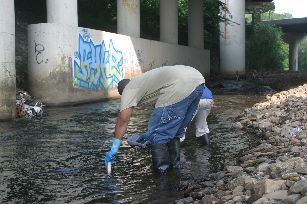 ...................................................
...................................................
Water sampling at an urban stream in Baltimore City ..............................Kids fishing at a sewer outfall on an urban stream
Background:
In a fully urbanized area where development is relatively static and capital water quality control projects tend to be prohibitively expensive, low impact redevelopment is a critical need to be addressed. People and businesses residing in metropolitan areas need to be better informed about natural resource processes (relationships between land use, forests and other vegetation, water quality, and living resources), how their actions affect the quality of water flowing to storm drains, streams, and estuaries, and how to undertake resource stewardship activities in practical and meaningful ways.
Watershed-based management planning is the ideal tool to address these objectives. Watershed management science is rapidly evolving being complemented by state and federal mandates including the Municipal Stormwater Permit Program, Total Maximum Daily Load Program and Chesapeake Bay Program. Organizations such as the Center for Watershed Protection have identified key principles and prepared guidelines for developing watershed management plans. Many of these principles are being implemented through numerous watershed restoration efforts across the Bay Region. Existing watershed management models do not work in blighted, inner-city areas such as Watershed #263. This is because urban, inner city neighborhoods are typically isolated from environmental resources that would benefit from their action and the use of conventional urban restoration practices (e.g., wetland creation) is prohibitively expensive.
Research Objectives:
The primary goal of this research is to measurably improve water quality, Chesapeake Bay living resources, and social and environmental conditions in a small urban storm sewer watershed area through the implementation of community-based restoration projects. This project is being carried out through a multi-organization collaboration among the City of Baltimore, Parks and People Foundation, The US Forest Service, KCI Technologies, and the University of Maryland Baltimore County.
Key questions to be addressed in this research at UMBC are:
1. What are the levels of key priority pollutants in the watershed effluent?
2. What are the sources of the prominent priority and emerging pollutants in the watershed?
3. How does the water quality change after the implementation of the restoration projects?